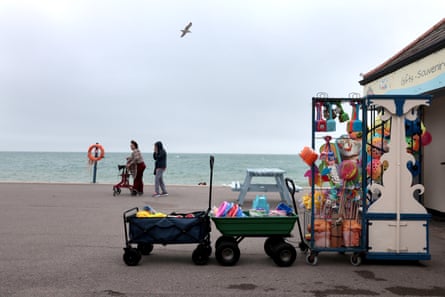One in seven English bathing spots rated as polluted in latest testing
November 25, 2025
One in seven (13%) of England’s bathing waters are rated as polluted, and one in 14 so polluted they are not recommended for swimming.
Famous beaches including Bognor Regis, Scarborough’s South Bay and Littlehaven Beach in South Shields were all rated “poor” in the latest classifications from the Department for Environment, Food and Rural Affairs (Defra), which means they are not recommended for swimming.
Of 449 designated bathing sites in England, 87% meet standards for “excellent” or “good” classification, an improvement on 2024, and 417 bathing waters (93%), were rated “excellent”, “good” or “sufficient”, representing a very slight rise on 2024’s standards.
Last year, bathing waters were the most polluted they have been since records began in 1991. Across the country, 450 locations have bathing water status and are tested during the summer season, from May to September. Last year a record number of areas – 37, or 8.2% – did not meet the minimum standards for bathing waters and were classified as poor.
Rivers, lakes and seas are polluted by agricultural run-off and sewage pollution dumped by water companies. This makes up almost all of the pollution in England’s waterways, but the Environment Agency has also blamed “birds and dogs” for the poor results.
Feargal Sharkey, the former Undertones frontman and water campaigner, told the Guardian: “The EA has started this thing of blaming seagulls and blaming dogs for pooing on beaches, because if they blame water companies at all it’s a failure of regulation and that’s their fault, whereas they don’t regulate seagulls shitting. It is an act of gross incompetence, much like its regulation of the environment, to blame seagulls for the failure of water companies.”

Fewer waterways are likely to be granted bathing status in future. Ministers recently announced a feasibility test on any waterway where a community is seeking a bathing water designation. If water bodies are deemed too polluted to improve to at least “sufficient” water quality, they will not be given a designation.
River campaigners have said the restriction is very likely to exclude river sites from being granted bathing water status. No single stretch of river in England is in good overall health and the rivers that have bathing water status at the moment all record poor water quality as a result of sewage and agricultural pollution.
The UK is still using the EU’s bathing water status framework to measure the quality of lakes, rivers and seas. But recent research found England’s waterways with bathing status are five times more likely to be polluted than those in the EU.
People swim and boat in far more waterways than are designated for bathing. A recent government analysis of the ways that England’s waterways are used for recreation found 3,347 “water recreation locations” in rivers, lakes and seas around the country. The Environment Agency had previously identified 342.
The water minister, Emma Hardy, said: “Our bathing waters are at the heart of so many communities, and these reforms will help people experience the benefits of our beautiful waters and connect with nature.
“By ending automatic de-designation and bringing in more flexibility to when waters are monitored, we’re creating a system that reflects how people actually use their local rivers, lakes and beaches.
“These changes sit alongside our wider action to clean up our waterways so communities across the country can enjoy the places they care about most.”
Search
RECENT PRESS RELEASES
Related Post




